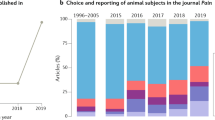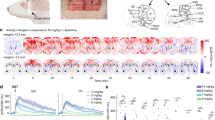Abstract
Sex differences in human responses to nociceptive stimuli and painful pathological conditions have generally indicated that women report higher pain levels or exhibit less tolerance than men for given stimulus intensities (reviewed in ref. 1 and 2). However, studies have not evaluated sex differences in analgesic responses. We recently reported that the opioid agonist–antagonist pentazocine, which acts predominantly at κ–receptors, produced significantly better postoperative analgesia in females than in males3,4 in patients who underwent surgery for the removal of their third molars (wisdom teeth). In the current study, we evaluated the hypothesis that this sex difference is a characteristic of κ–opioid agonism. In order to determine whether there are sex differences associated with κ–opioid agonism, the analgesic efficacy of two other predominantly κ–opioid analgesics, nalbuphine and butorphanol, was compared in males and females who underwent surgery for the removal of third molar teeth. We found that both nalbuphine and butorphanol produced significantly greater analgesia in females as compared with males. Considering our earlier findings, we conclude that κ–opioid analgesia is greater in females than in males, probably reflecting a difference in κ–opioid–activated endogenous pain modulating circuits.
This is a preview of subscription content, access via your institution
Access options
Subscribe to this journal
Receive 12 print issues and online access
$209.00 per year
only $17.42 per issue
Buy this article
- Purchase on Springer Link
- Instant access to full article PDF
Prices may be subject to local taxes which are calculated during checkout
Similar content being viewed by others
References
Fillingim, R.B. & Maixner, W. Gender differences in the responses to noxious stimuli. Pain Forum 4, 209–221 (1995).
Unruh, A.M. Gender variations in clinical pain experience. Pain 65, 123–167 (1996).
Gordon, N.C. et al. Enhancement of morphine analgesia by the GABAB agonist baclofen. Neuroscience 69, 345–349 (1995).
Gear, R.W. et al. Gender difference in analgesic response to the kappa-opioid pentazocine. Neurosci. Lett. 205, 207–209 (1996).
Dyrenfurth, I., Jewelewicz, R., Warren, M., Ferin, M. & Vande Wiele, R.L. Temporal relationships of hormonal variables in the menstrual cycle. in Biorhythms and Human Reproduction (ed. Ferin, M. et al.) 171–201 (Wiley & Sons, New York, 1974).
Reisine, T. & Pasternak, G. Opioid analgesics and antagonists. in Goodman & Gilman's The Pharmacological Basis of Therapeutics, 9th edn (eds. Hardman, J.G. & Limbird, L.E.) 521–555 (McGraw-Hill, New York, 1996).
Pare, W.P., Age, sex, and strain differences in the aversive threshold to grid shock in the rat. J. Comp. Physiol. Psychol. 69, 214–218 (1969).
Beatty, W.W. & Beatty, P.A. Hormonal determinants of sex differences avoidance behavior and reactivity to electric shock in the rat. J. Comp. Physiol. Psychol. 73, 446–455 (1970).
Marks, H.E. & Hobbs, S.H. Changes in stimulus reactivity following gonadectomy in male and female rats of different ages. Physiol. Behav. 8, 1113–1119 (1972).
Romero, M.T. & Bodnar, R.J. Gender differences in two forms of cold-water swim analgesia. Physiol. Behav. 37, 893–897 (1986).
Romero, M.T., Cooper, M.L., Komisaruk, B.R. & Bodnar, R.J. Gender-specific and gonadectomy-specific effects upon swim analgesia: Role of steroid replacement therapy. Physiol. Behav. 44, 257–265 (1988).
Kepler, K.L. & Bodnar, R.J. Yohimbine potentiates cold-water swim analgesia: Re-evaluation of a noradrenergic role. Pharmacol. Biochem. Behav. 29, 83–88 (1988).
Aloisi, A.M., Albonetti, M.E. & Carli, G. Sex differences in the behavioural response to persistent pain in rats. Neurosci. Lett. 179, 79–82 (1994).
Coyle, D.E., Sehlhorst, C.S. & Mascari, C. Female rats are more susceptible to the development of neuropathic pain using the partial sciatic nerve ligation (PSNL) model. Neurosci. Lett. 186, 135–138 (1995).
Kepler, K.L., Kest, B., Kiefel, J.M., Cooper, M.L. & Bodnar, R.J. Roles of gender, gonadectomy and estrous phase in the analgesic effects of intracerebroventricular morphine in rats. Pharmacol. Biochem. Behav. 34, 119–127 (1989).
Baamonde, A.I., Hidalgo, A. & Andres-Trelles, F. Sex-related differences in the effects of morphine and stress on visceral pain. Neuropharmacology 28, 967–970 (1989).
Kepler, K.L. et al. Gender effects and central opioid analgesia. Pain 45, 87–94 (1991).
Candido, J. et al. Effect of adrenal and sex hormones on opioid analgesia and opioid receptor regulation. Pharmacol. Biochem. Behav. 42, 685–692 (1992).
Halpern, S.H. & Carter, J.H. Narcotic agonists versus agonist-antagonist for relief of labor pain: A meta-analysis. Anesth. Analg. 82, S159 (1996).
Wilson, S.J., Errick, J.K. & Balkon, J. Pharmacokinetics of nalbuphine during parturition. Am. J. Obstet. Gynecol. 155, 340–344 (1986).
Jaillon, P. et al. Pharmacokinetics of nalbuphine in infants, young healthy volunteers, and elderly patients. Clin. Pharmacol. Ther. 46, 226–233 (1989).
Shyu, W.C., Morgenthien, E.A., Pittman, K.A. & Barbhaiya, R.H. The effects of age and sex on the systemic availability and pharmacokinetics of transnasal butorphanol. Eur. J. Clin. Pharmacol. 47, 57–60 (1994).
Gintzler, A.R. Endorphin-mediated increases in pain threshold during pregnancy. Science 210, 193–195 (1980).
Cogan, R. & Spinnato, J.A. Pain and discomfort thresholds in late pregnancy. Pain 27, 63–68 (1986).
Dawson-Basoa, M.B. & Gintzler, A.R. 17-Beta-estradiol and progesterone modulate an intrinsic opioid analgesic system. Brain Res. 601, 241–245 (1993).
Sander, H.W., Portoghese, P.S. & Gintzler, A.R. Spinal kappa-opiate receptor involvement in the analgesia of pregnancy: Effects of intrathecal nor-binaltor-phimine, a kappa-selective antagonist. Brain Res. 474, 343–347 (1988).
Musacchio, J.M. The psychotomimetic effects of opiates and the sigma receptor. Neuropsychopharmacology 3, 191–200 (1990).
Pande, A.C. et al. Analgesic efficacy of the κ-receptor agonist, enadoline, in dental surgery pain. Clin. Neuropharmacol. 19, 92–97 (1996).
Levine, J.D. & Gordon, N.C. Influence of the method of drug administration on analgesic response. Nature 312, 755–756 (1984).
Levine, J.D., Gordon, N.C., Taiwo, Y.O. & Coderre, T.J. Potentiation of pentazocine analgesia by low-dose naloxone. J. Clin. Invest. 82, 1574–1577 (1988).
Faucett, J., Gordon, N. & Levine, J. Differences in postoperative pain severity among four ethnic groups. J. Pain Symptom Manage. 9, 383–389 (1994).
Author information
Authors and Affiliations
Rights and permissions
About this article
Cite this article
Gear, R., Miaskowski, C., Gordon, N. et al. Kappa–opioids produce significantly greater analgesia in women than in men. Nat Med 2, 1248–1250 (1996). https://doi.org/10.1038/nm1196-1248
Received:
Accepted:
Issue Date:
DOI: https://doi.org/10.1038/nm1196-1248
This article is cited by
-
PET imaging of kappa opioid receptors and receptor expression quantified in neuron-derived extracellular vesicles in socially housed female and male cynomolgus macaques
Neuropsychopharmacology (2023)
-
Spezielle Aspekte der pharmakotherapeutischen Behandlung forensisch untergebrachter Patientinnen
Forensische Psychiatrie, Psychologie, Kriminologie (2023)
-
The Opioid Analgesic Reduction Study (OARS)—a comparison of opioid vs. non-opioid combination analgesics for management of post-surgical pain: a double-blind randomized clinical trial
Trials (2022)
-
Sexual dimorphism in the prevalence, manifestation and outcomes of axial spondyloarthritis
Nature Reviews Rheumatology (2022)
-
ED50 of Propofol Combined with Nalbuphine on the Sedative Effect in Painless Hysteroscopy
Pain and Therapy (2021)



